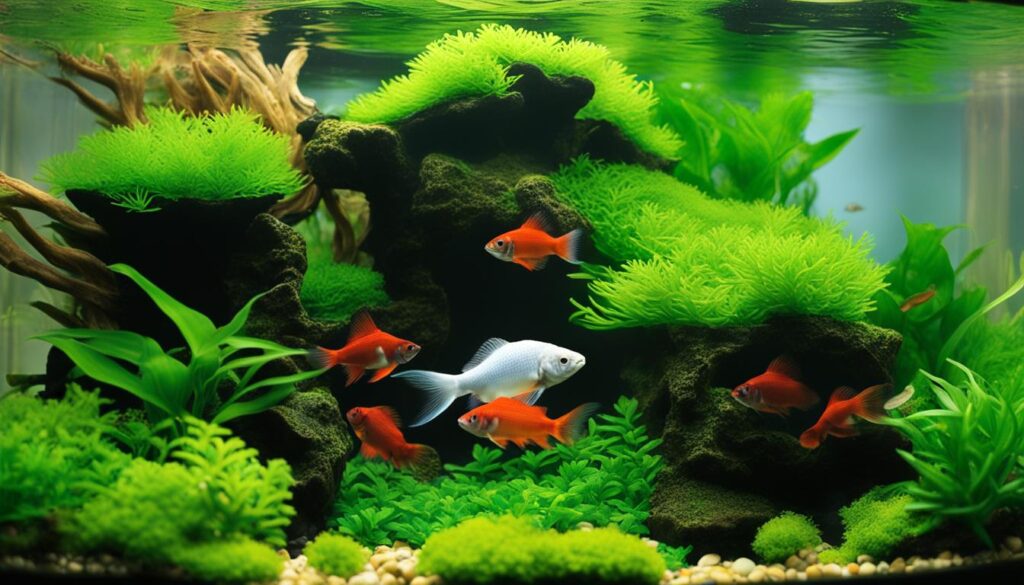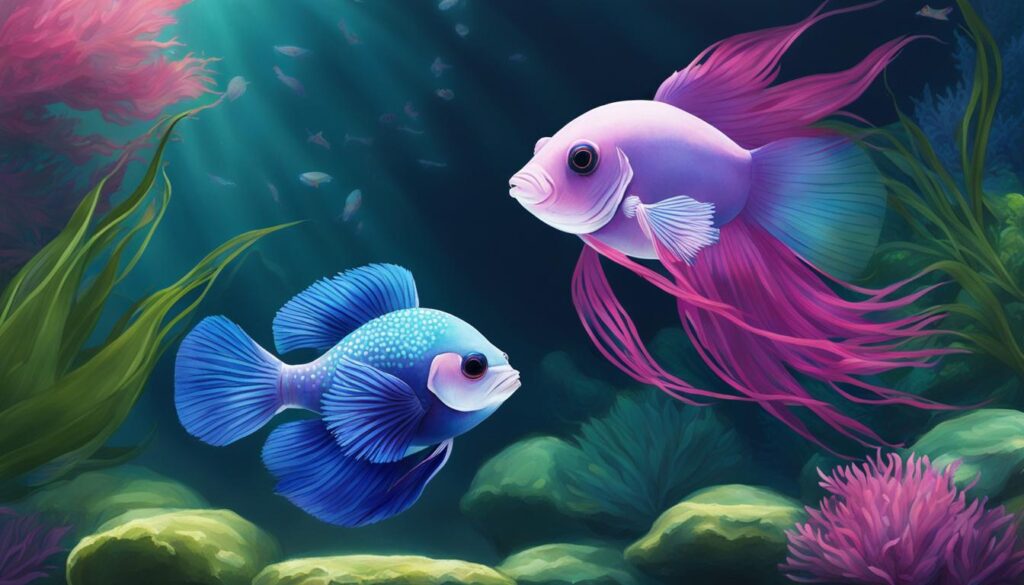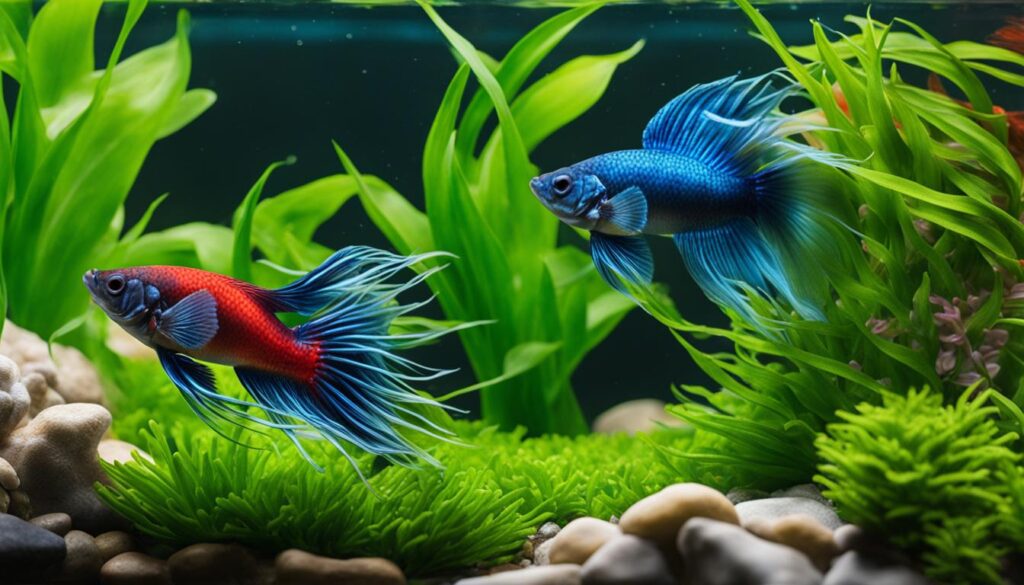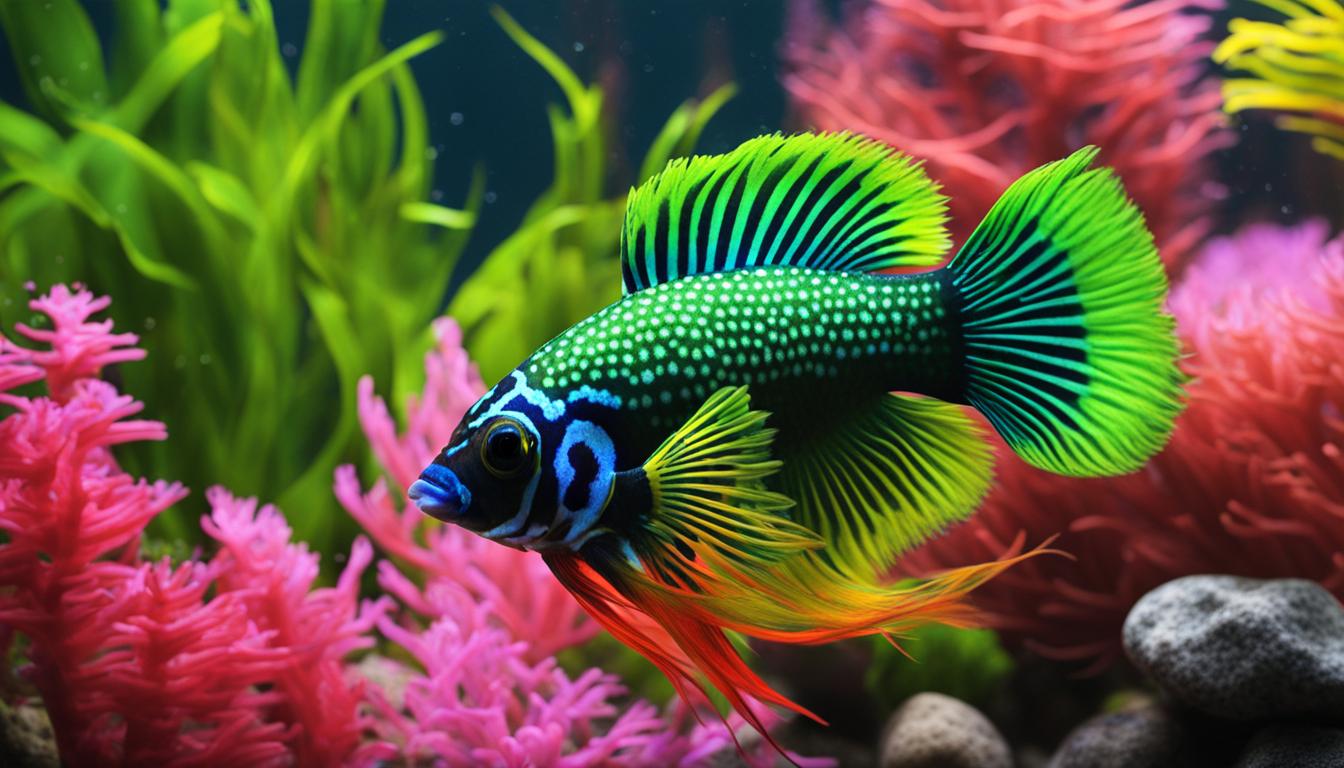Greetings, fellow aquarium enthusiasts! Today, I’m excited to introduce you to a unique and fascinating combination – a pea puffer with a betta fish in the same tank. While pairing different fish species in the same aquarium is not uncommon, this particular pairing requires some special attention and preparation to ensure a harmonious environment for both.
In this guide, I will walk you through all the necessary steps to successfully keep a pea puffer with a betta fish, including setting up the ideal tank environment, introducing them properly, and maintaining their well-being. Whether you’re a seasoned aquarist or just starting out, this guide will provide everything you need to know to create a thriving and peaceful pea puffer and betta community.
Table of Contents
Key Takeaways:
- Pairing a pea puffer with a betta fish requires special attention and preparation.
- Creating a suitable environment for both is crucial for their well-being.
- Observing their behavior and health is essential for maintaining a harmonious community.
- Addressing aggression or compatibility issues promptly is necessary.
- Proper care and maintenance are crucial for the success of this unique aquarium pairing.
Understanding Pea Puffers and Bettas
When considering housing a pea puffer with a betta fish, it’s important to understand the unique characteristics of both species to ensure a harmonious environment. Puffer fish and betta tank mates are not a traditional pairing, but with care and proper setup, they can coexist peacefully.
Pea puffers, also known as dwarf puffers, are freshwater fish native to South Asia. They are small, reaching a maximum size of 1.5 inches, and are known for their distinctive round shape. Pea puffers can be kept in groups, but they are also content to live alone. They are carnivores and require live or frozen food, such as brine shrimp or bloodworms, as part of their diet.
Bettas, also known as Siamese fighting fish, are freshwater fish native to Southeast Asia. They are known for their vibrant colors and flowing fins, making them a popular choice for aquariums. Bettas are solitary fish and should not be kept with other bettas, but they can coexist with other peaceful fish, such as pea puffers. They are also carnivores and require a varied diet that includes live or frozen food.
Keeping Pea Puffers and Bettas Together
The compatibility of pea puffer and betta is based on several factors, including behavior, diet, and tank setup. Pea puffers can be aggressive and territorial, especially towards their own kind, so it’s essential to provide ample hiding spots and enough space for both fish. Bettas can also be aggressive towards other bettas, but they tend to be less aggressive towards other fish.
When keeping pea puffers and bettas together, it’s important to provide a varied diet that meets the needs of both fish. Live or frozen food, such as brine shrimp or bloodworms, should be provided regularly for both species.
The ideal tank setup for pea puffers and bettas is a planted tank with hiding spots and a size of at least 10 gallons. A filter and regular water changes are necessary to maintain proper water parameters and ensure a healthy environment for both fish.
Tip: When introducing pea puffers and bettas to a shared tank, it’s best to add them at the same time to avoid establishing territory.
Overall, keeping pea puffers and bettas together is possible with proper care and setup. Understanding their characteristics and needs is key to maintaining a peaceful and healthy environment.
Setting Up the Ideal Tank Environment

When it comes to housing a pea puffer with a betta fish, creating the ideal tank environment is crucial for their well-being. Here are some key guidelines to follow:
| Aspect | Ideal conditions |
|---|---|
| Tank size | A minimum of 20 gallons for one betta and one pea puffer. Add an extra 5 gallons for each additional fish. |
| Water parameters | The temperature should be between 76-82°F with a pH range of 6.5-7.5 and a water hardness of 5-20 dGH. |
| Decorations | Add live plants, driftwood, and rocks to give your fish hiding spots and create a natural environment. Avoid sharp edges and small spaces that may harm or trap your fish. |
It’s crucial to ensure that the tank is cycled and the filter is working efficiently to maintain good water quality. Regular water changes of at least 25% every two weeks are also recommended.
Incorporating a heater and thermometer will maintain consistent water temperatures, and a light source can mimic natural daylight and support plant growth. It’s essential to avoid direct sunlight or sudden temperature changes as they may cause stress and harm your fish.
Pea puffers and bettas require plenty of space to swim and explore, so avoid overcrowding the tank. Provide plenty of open swimming spaces with hiding spots to encourage your fish to establish their territories and minimize aggression.
By creating a suitable tank environment, you can ensure the well-being of your pea puffer and betta fish. Next, I’ll provide practical tips for introducing pea puffers to an existing betta tank.
Introducing Pea Puffers to a Betta Tank
Introducing pea puffers to a betta tank requires patience and careful planning to ensure a successful transition. Here are some tips that can help:
- Quarantine the pea puffer: Before introducing the pea puffer to the betta tank, quarantine it for at least two weeks in a separate tank. This will help prevent the spread of any potential diseases or parasites and allow the pea puffer to adjust to its new environment.
- Rearrange the tank: Before introducing the pea puffer, rearrange the decorations and plants in the betta tank. This will help disrupt the betta’s territorial behavior and reduce the chances of aggression.
- Introduce the pea puffer: When introducing the pea puffer, turn off the tank lights and place the pea puffer in a clear container or bag with some of the tank water. Float the container in the tank for about an hour to allow the pea puffer and betta to see each other. Then, release the pea puffer into the tank.
- Observe their behavior: Monitor the pea puffer and betta closely during the first few days. This will give you an idea of their behavior and compatibility levels. If there are signs of aggression, such as fin nipping or chasing, separate them immediately and try again later.
These tips can help increase the chances of a successful introduction of pea puffers to a betta tank. Remember to take your time and observe their behavior regularly to ensure a harmonious tank environment.
Creating a Peaceful Environment

Pea puffers and bettas can coexist peacefully in an aquarium if the right environment is created. Here are some tips for creating a stress-free and peaceful environment:
Provide ample space
Make sure the aquarium size is suitable for both pea puffers and bettas. A tank of at least 20 gallons is recommended for one betta and a few pea puffers. Providing enough space ensures that both species have enough room to swim and establish their own territories.
Add hiding spots
Pea puffers are shy and need a place to hide, while bettas like to establish their territory. Adding hiding spots, such as plants, rocks, and caves, helps to provide cover for pea puffers and reduces territorial aggression from bettas.
Reduce aggressive behavior
Aggressive behavior can occur when pea puffers and bettas compete for territory. Reduce aggression by providing enough hiding spots and dividing the tank into sections. Dividers can help to separate the fish and decrease aggression. It’s important to monitor their behavior and remove any aggressive fish immediately.
Monitor water parameters
Maintaining proper water parameters is essential for the health of both pea puffers and bettas. Regularly test the water for ammonia, nitrite, nitrate, pH, and temperature. Keep the water clean by performing regular water changes and using a good filtration system.
“Creating a stress-free environment is crucial for the success of this unique aquarium pairing.”
Overall, creating a stress-free environment is crucial for the success of this unique aquarium pairing. By providing enough space, adding hiding spots, reducing aggressive behavior, and monitoring water parameters, pea puffers and bettas can coexist peacefully in an aquarium.
Maintaining Water Quality

One of the key factors in ensuring a harmonious pea puffer and betta community is maintaining excellent water quality. Regular water testing and filtration are crucial for the health and well-being of both species.
It’s recommended to test your water weekly using a high-quality test kit to ensure that the ammonia, nitrate, and nitrite levels are within safe parameters. It’s also essential to perform regular water changes to keep the water clean and clear of any harmful toxins.
When it comes to filtration, a good quality filter is necessary for keeping the water clean and free from harmful bacteria. Ensure that the filter is appropriate for the tank size and that the flow is not too strong, which can stress out your fish.
Another essential factor to consider is proper feeding. Overfeeding can lead to excess waste and uneaten food, which can quickly degrade water quality. Feed your fish small portions of high-quality food once or twice a day, and remove any uneaten food after a few minutes.
By maintaining excellent water quality, you’ll be able to provide a healthy environment for your pea puffer and betta community. Both species will thrive in a clean and clear tank, and you’ll be able to enjoy their peaceful coexistence for years to come.
Dealing with Aggression and Compatibility Issues
While pea puffers and bettas can make suitable tank mates, there may be instances of aggression or compatibility issues that arise. Here are some strategies for dealing with these situations:
Separating the Fish
If your pea puffer and betta are constantly fighting or showing signs of stress, it may be necessary to separate them into different tanks. This can help reduce aggression and promote a healthier environment for each fish.
Creating a Divided Tank
If you still want to keep both fish in the same tank, creating a divided tank may be a viable option. This involves setting up a barrier to physically separate the two fish while still allowing them to live in the same tank.
One option for a divided tank is to use a clear acrylic divider. You can use silicone to attach the divider to the tank and then drill small holes to allow water flow. This will prevent the two fish from physically interacting while still allowing them to share the same environment.
Providing Hiding Spots
Another strategy for reducing aggression is to provide ample hiding spots for both the pea puffer and betta. This allows each fish to have their own space to retreat to and reduces the chances of conflict.
You can place plants, rocks, and other decorations in the tank to create hiding spots. Just be sure to arrange them in such a way that neither fish feels trapped or cornered by the other.
Observing the Fish
It’s important to observe the behavior of both the pea puffer and betta to determine if they are compatible tank mates. If you notice any signs of stress or aggression, it may be time to reevaluate and make changes to their living situation.
Some signs of stress to look out for include:
- Excessive hiding
- Rapid breathing
- Loss of appetite
- Clamped fins
- Aggressive behavior
If you notice any of these signs, it may be necessary to separate the fish or create a divided tank to reduce stress levels.
Observing Behavior and Health
Keeping pea puffers and bettas together in an aquarium is an exciting and unique experience. To ensure their well-being, it is essential to observe their behavior and health regularly. Here are some tips on what to look for:
Behavior
It is normal for pea puffers and bettas to display some territorial behavior, especially during feeding time. However, constant chasing or fin nipping is a sign of stress and aggression. If you notice this behavior, it may be necessary to separate them.
On the other hand, peaceful interactions, such as swimming together or sleeping in the same area, indicate a harmonious environment. Remember to provide ample space and hiding spots for both species to reduce stress and promote peaceful interactions.
Health
Pea puffers and bettas are susceptible to various diseases, including fin rot, dropsy, and ich. Keeping a clean tank and maintaining proper water parameters can prevent these illnesses. However, if you notice any signs of illness, such as lethargy, loss of appetite, or abnormal swimming behavior, take action immediately.
Regular water testing and proper feeding can also promote good health. Check water parameters weekly and adjust as necessary. Ensure that they receive a varied diet, including live or frozen food, to enhance their immune system.
Observing behavior and health is crucial for keeping pea puffers and bettas together successfully. If you notice any problems, take action immediately, and consult with a knowledgeable aquatic veterinarian if necessary.
Troubleshooting and FAQs
While pea puffers and bettas can coexist peacefully in a well-maintained aquarium, there may be some challenges along the way. Here are some common troubleshooting issues and frequently asked questions to help you in successfully cohabitating pea puffers and bettas:
How do I deal with aggression between my pea puffer and betta?
It’s important to observe the behavior of both species and take action if necessary. If you notice aggression, try providing additional hiding spots or rearranging decorations to create more territory for each fish. If aggression persists, consider providing separate tanks for each species.
My pea puffer isn’t eating, what should I do?
Pea puffers are carnivorous and require a protein-rich diet. If your pea puffer isn’t eating, try offering different types of food such as live or frozen bloodworms, brine shrimp, or small pieces of fish or shrimp. If there are still issues, consult with a veterinarian or aquarium specialist.
What size tank do I need for pea puffers and bettas?
Both pea puffers and bettas require adequate space to swim and explore. A minimum of 10 gallons is recommended for a single betta, and an additional 5-10 gallons for each pea puffer. Keep in mind that larger tanks will also require more filtration and maintenance.
Can I house more than one pea puffer and betta together?
While it’s possible to house multiple pea puffers and bettas together, it’s important to provide enough space and hiding spots. Aggression and territorial disputes may still arise, so close observation and proper care are essential.
What are some signs of stress or illness in my pea puffer or betta?
Signs of stress or illness may include lethargy, loss of appetite, changes in coloration or behavior, and physical symptoms such as lesions or fin rot. Regular observation and water testing can help detect issues early on, and prompt treatment can prevent further complications.
Remember, successful cohabitation of pea puffers and bettas requires proper care, observation, and patience. If you encounter any issues, don’t hesitate to seek guidance from an aquarium specialist or veterinarian.
Conclusion
And there you have it! By following the guidelines and tips I provided, you can successfully pair your pea puffer with a betta fish in the same aquarium.
Remember, it’s important to understand the behavior and compatibility of these species before introducing them to each other. Setting up the ideal tank environment, minimizing aggression, and maintaining water quality are key factors in keeping them healthy and happy.
If any issues arise, don’t panic. Simply observe their behavior, make adjustments as needed, and monitor their health closely. And if all else fails, there are alternative tank setups that can provide a peaceful environment for both species.
Final Thoughts
Pairing a pea puffer with a betta fish can be a unique and rewarding experience for any aquarium enthusiast. Not only does it provide a visually appealing display, but it also allows for a rare opportunity to observe two different species interact in their shared environment.
As with any pet, providing the best possible care is crucial for their well-being. With proper care, observation, and attention to detail, you can create a harmonious and thriving community of pea puffers and bettas in your aquarium.
Thank you for joining me on this journey, and I wish you all the best in your pea puffer and betta tank-keeping endeavors!
FAQ
Can I keep pea puffers and bettas together in the same tank?
Yes, it is possible to keep pea puffers and bettas together in the same tank. However, caution must be taken to ensure compatibility and a peaceful environment for both species.
What size tank is ideal for housing pea puffers and bettas?
For a successful pea puffer and betta pairing, a tank size of at least 10 gallons is recommended. This provides enough space for each fish to establish territories and reduces the likelihood of aggression.
How do I introduce pea puffers to an existing betta tank?
When introducing pea puffers to an existing betta tank, it is important to acclimate them gradually. Use a breeder net or a separate container within the tank to allow both species to see and adjust to each other over a period of time. This helps reduce aggression and stress during the introduction process.
What can I do to create a peaceful environment for pea puffers and bettas?
To create a peaceful environment for pea puffers and bettas, provide ample hiding spots and visual barriers within the tank. This helps reduce confrontational behaviors and allows each fish to establish their own territories. Additionally, avoid overcrowding the tank and ensure proper feeding to prevent competition for resources.
How do I maintain water quality in a tank with pea puffers and bettas?
Maintaining excellent water quality is crucial for the well-being of pea puffers and bettas. Regular water testing, proper filtration, and performing regular water changes are essential. Additionally, be mindful of the specific water parameters required by each species and adjust accordingly.
What should I do if aggression or compatibility issues arise between pea puffers and bettas?
If aggression or compatibility issues arise between pea puffers and bettas, it may be necessary to separate them into individual tanks. Providing alternative tank setups with different tank mates or adjusting the tank environment may also help alleviate aggression. Always monitor their behavior closely and take appropriate action to ensure the safety and well-being of each fish.
How can I observe the behavior and health of pea puffers and bettas in a shared tank?
To observe the behavior and health of pea puffers and bettas in a shared tank, pay attention to their eating habits, swimming patterns, and interactions with each other. Look for any signs of stress or illness such as loss of appetite, lethargy, or abnormal swimming behavior. Regular observation and monitoring are key to maintaining a healthy and thriving aquarium community.
What should I do if I encounter any issues while keeping pea puffers and bettas together?
If you encounter any issues while keeping pea puffers and bettas together, refer to the troubleshooting section of this guide. We have provided solutions and additional guidance to address common problems that may arise. If you require further assistance, consult with a knowledgeable fishkeeper or seek advice from a reputable aquarium forum or store.
I am a passionate aquarist with over 30 years of hands-on experience in fishkeeping. My journey began at a young age, collecting fish from the wild and learning through experimentation. Specializing in tropical fish, I bring a deep understanding of the hobby to FishKeepingMadeSimple. The site provides honest, detailed reviews of essential products and accessories to help fellow enthusiasts create the best environments for their fish.










[…] color variations, ranging from silver and striped to panda, albino, and neon. Each variety adds its unique charm to your aquarium, creating a visually appealing and diverse underwater landscape. Whether you choose the standard, […]
[…] Barbs are a stunning fish with their golden bodies, red fins, and black spots. Their size and unique look make them a great choice for aquariums. They are truly unique and captivating […]